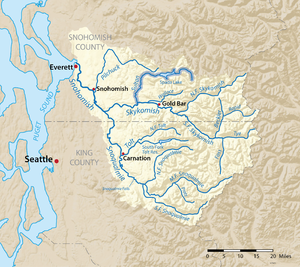| Sultan River | |
|---|---|
 The Sultan River a few miles downstream of Culmback Dam near a USGS stream gauge and a diversion dam | |
 The Sultan River highlighted on a map of the Snohomish River watershed | |
| Etymology | Snohomish Chief Tsul-tad |
| Location | |
| Country | United States |
| State | Washington |
| County | Snohomish |
| Physical characteristics | |
| Source | Cascade Range |
| • coordinates | 47°56′53″N 121°28′4″W / 47.94806°N 121.46778°W[1] |
| Mouth | Skykomish River |
• location | Sultan |
• coordinates | 47°51′28″N 121°49′13″W / 47.85778°N 121.82028°W[1] |
| Length | 30 mi (48 km)[2] |
| Basin size | 80 sq mi (210 km2) |
| Discharge | |
| • location | USGS gage 12138160, Sultan River below Powerplant, near Sultan, WA, river mile 4.5[3] |
| • average | 735 cu ft/s (20.8 m3/s)[3] |
| • minimum | 157 cu ft/s (4.4 m3/s) |
| • maximum | 20,100 cu ft/s (570 m3/s) |
The Sultan River is a river in Snohomish County in the U.S. state of Washington. It is a tributary of the Skykomish River, which it joins at the town of Sultan, Washington. The river is dammed in its upper third by Culmback Dam to form Spada Lake.
Both the Sultan River and the town of Sultan were named by prospectors for the chief of a Snohomish sub-tribe who lived on the Skykomish River in the 1870s. His name was Tsul-tad or Tseul-tud, which was anglicized by the miners into Sultan.[4]
The Sultan River's drainage basin was subjected to intense glaciation during the Pleistocene era. The river flows through a well-defined glacially carved trench. The upper South Fork Sultan River flows through a classic U-shaped valley cut by a glacier through Quartz diorite. The Sultan's river main tributaries—the North Fork, South Fork, Elk Creek, and Williamson Creek— flow through narrow valleys to converge in the lower Sultan basin where the valley floor is relatively broad. The Sultan River exits this basin by plunging abruptly into and through a narrow canyon.[5]
Pleistocene glaciers spread down the valleys of the Sultan River and its tributaries, merging in the lower basin. From there the ice pushed west through what is now the Pilchuck River valley. Today the two rivers are separated by the terminal moraine of an ice front that spread up the Pilchuck valley and impounded the Sultan River, creating a lake. This glacial lake eventually drained westward, creating a delta moraine. The postglacial Sultan River cut through the delta moraine, establishing its present course out of the lower Sultan basin.[5]
- ^ a b U.S. Geological Survey Geographic Names Information System: Sultan River
- ^ Calculated in Google Earth
- ^ a b "Water Resources Data-Washington Water Year 2005; Snohomish River Basin" (PDF). USGS. Retrieved 5 August 2009.
- ^ "Sultan". Washington Place Names database. Tacoma Public Library. Archived from the original on 2009-03-09. Retrieved 2009-03-05.
- ^ a b Beckey, Fred (2003). Cascade Alpine Guide: Climbing and High Routes: Stevens Pass to Rainy Pass (3rd ed.). The Mountaineers. pp. 25–26, 30. ISBN 0-89886-423-2.
© MMXXIII Rich X Search. We shall prevail. All rights reserved. Rich X Search


